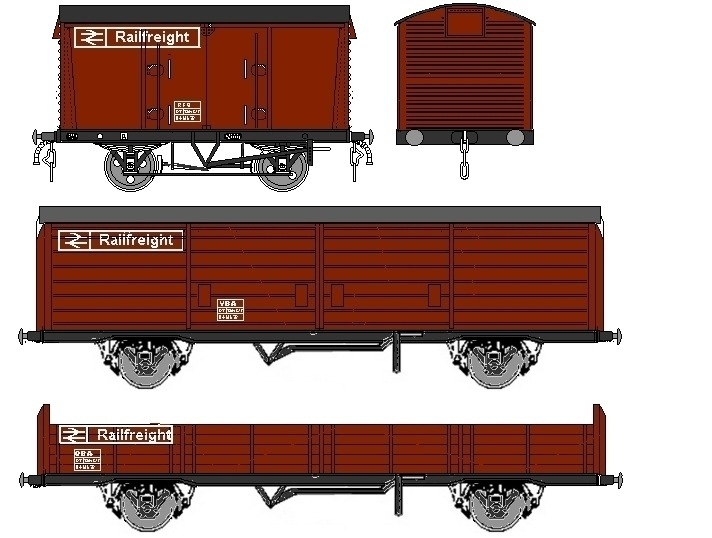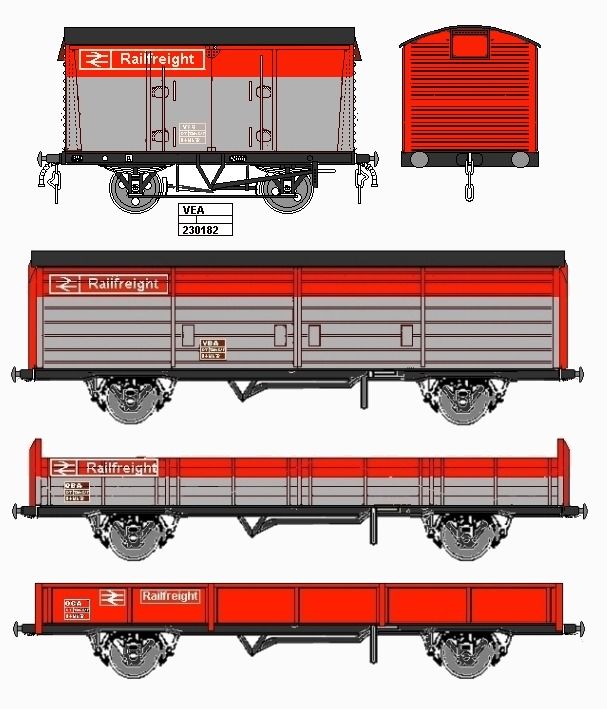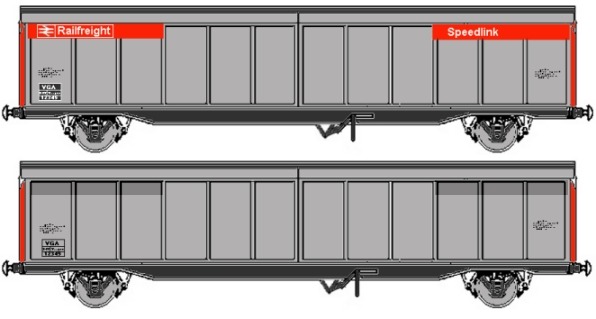
| Return to index page |
British Rail TOPS era 1975-privatisation
NB The colours used were obtained by sampling colour pictures, they may however vary from the true colour, use as a rough guide only
1974 saw the general introduction of the TOPS (Total Operations Processing System) computer controlled operations, in which every wagon and van, with its load, location and what have you is listed on computer. The TOPS codes consist of four letters but only the first three are painted on the rolling stock, replacing the old telegraphic code names. Unlike the telegraphic code names the TOPS codes are painted on all rolling stock. TOPS codes appear in a `data panel' on the vehicle side, the information being in white lettering in a collection of rectangular frames in white. A list of TOPS codes which might interest the modeller has been included in Appendix 1 (note TOPS codes have been revised at intervals, notably in 1983).
The HAA hopper from Hornby Minitrix is in early TOPS livery, plain metal body, bauxite body framing and black underframe. The lettering on the aluminium coloured body is in black, that on the underframe is in white. The TOPS lettering on the hopper is I believe in white on a black panel. As noted above these wagons were the last type to be given numbers with the B prefix.
The original official standard for Railfreight livery was introduced in the late 1970's. The standard body colour was maroon, sometimes incorrectly referred to as bauxite. It was actually darker than the old passenger stock maroon and is similar to but slightly darker than EWS freight maroon I believe. This appeared on all the new air braked rolling stock and was also applied to older vacuum braked vans, some open wagons and hoppers and even a few steel carrying wagons. The double arrow logo and word Railfreight appeared in white, with a white box round them, in the upper left of the body.
British Rail ('Railfreight' era - 1975 - 1990) 
In about 1980 a new livery appeared, mainly in connection with the Speedlink services but also occasionally applied to other rolling stock such as steel carrying wagons. This new livery retained the black chassis but the body changed to a two tone livery of red and grey. The upper part of the body was painted `flame red' (very similar to poppy red) with a light grey on the lower area. On low vehicles such as bolster wagons and the OCA open wagons the sides were all red. On vans and some open wagons the word Railfreight was painted towards the upper left of the body side in white, usually accompanied by the British Rail double-arrow logo and normally enclosed in a white rectangle. On some lower sided open wagons, such as the OCA, the Railfreight logo and double arrow were painted on the right of the upper body as there would not be sufficient room for them above the standard TOPS data panel on the left. All lettering was in white, strangely the writing on the pale grey areas was not on a black patch (making it quite difficult to read. One exception (there may have been others) was on the lower body of the HEA hopper, it has a black patch to carry the white markings, again bounded by a white line `box'. The HAA/HDA MGR coal hopper retained the aluminium body sheeting with dull bauxite framing.
Traffic brake vans (there were still a few left as late as 1995) were in standard red/grey but do not appear to have the logo or the word Railfreight displayed, just a plain red band.
Fig ___ 1980 Railfreight freight stock liveries 
There were occasional variations, such as VGA vans introduced in 1981, these had red ends and plain metal sides. On some early examples a plate was fitted in the upper left corner of the body side to carry the logo and Railfreight in boxed white on a red background. Some also had a similar plate in the upper right carrying the word Speedlink in white on a red ground. These plates tended to fall off, or worse hang loose and out of gauge, so they were removed in the later 1980's, leaving the VGA's with plain metal sides. Where the signs had been there was usually some discolouration (this varied from a slight lightening of the area to a marked darkening). Some then had a plastic stick-on sign added at the left carrying the standard logo and word Railfreight in boxed white on a red ground, the label was not cut to fit so it wrapped over the vertical bar. Most lettering was in black but I believe some early vans had a black patch with the TOPS panel in white as shown in the upper sketch below. The VGA vans remained in the lower livery shown until privatisation, some were certainly in this livery in 2001.
Fig ___ Railfreight era VGA vans 
The official livery for the Freightliner container flats remained plain rail-blue, however the examples seen have been closer to Humbrol track colour from accumulated brake dust.
The parcels rolling stock in this period was re-painted rail blue with black roof and white lettering. Some British Rail built stock was allocated to the Inter-city system and received a blue and grey body to match the passenger coaches.
The Carflat wagons (converted coach underframes used for the Motorail service) were in rail blue with a white board half way along the side about a foot high bearing the double arrow logo in red to the left and the word `Motorail' to the right of this, in black.
Fig ___ Motorail car flat 